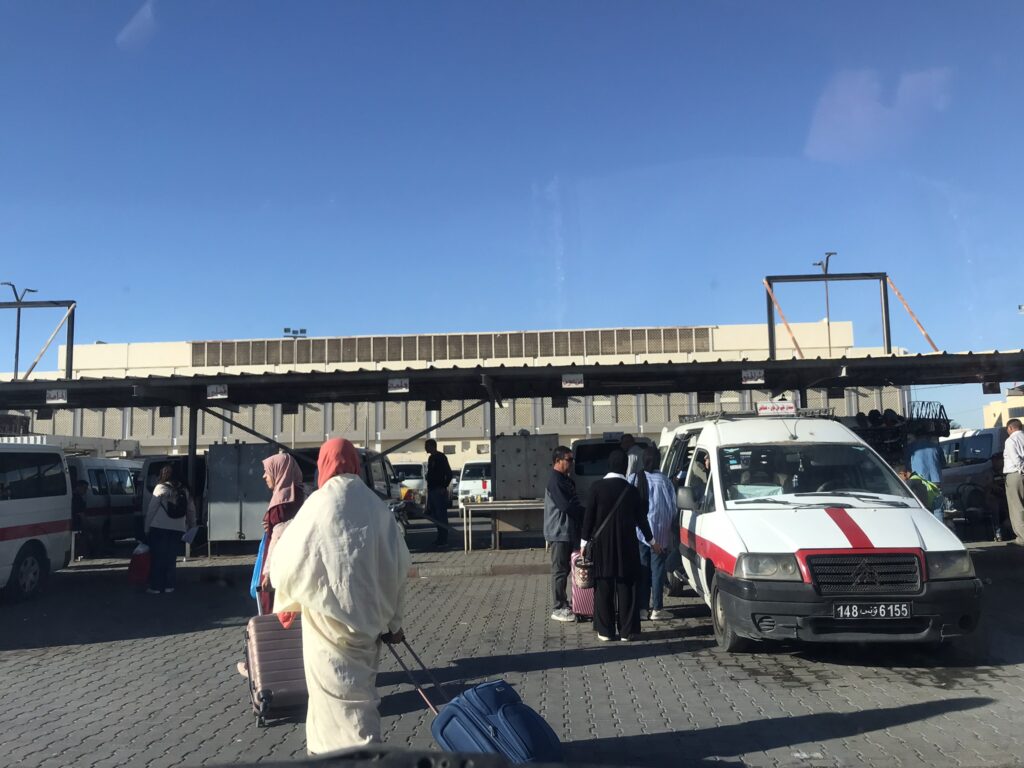
The best form of public transport in Tunisia is the louage, which is basically a shared taxi/minibus with between 7 and 9 passengers. The louages depart from stations and have set routes and set fares but do not operate with set timetables, the vehicles just depart once they are full of passengers. This means that after buying a ticket you might be waiting around a little while for the vehicle to fill up, or you might get lucky and get the last tickets in which case the louage will depart straight away!
I have to shout this from the rooftops, I am a big fan of the louage system. Louages are cheap and such an easy way to get from city to city. Most journeys cost between 10-15 TDN to get from one city to another and we never spent more than £5 on a louage trip. There are local louages which make shorter journeys between local towns and villages (these have yellow or blue stripes) and long-distance louages (red stripe) which travel between cities.
This post is all about louages, how to catch one, where to catch one and what destinations you can reach.
Listen up!
How to catch a louage
Check which louage station you need. Depending on the city there may be separate stations for local louages and long-distance louages, or both could be based in one station. Sometimes louages to different destinations may go from different stations on opposite sides of a city, so it is good to clarify and double check before setting off to make sure you go to the right station. Some louage stations are very organised with ticket booths, set parking bays and signs indicating which vehicles are going to where, while other louage ‘stations’ might just be a large gravel car park or even just some vehicles parked in a layby or at the side of the road (this is common for the local louages).
Arrive early in the morning, louages are most frequent between 6am-midday. If you’re planning a day trip and need to return by louage, you really need to aim to be back at the louage station to return before 1pm or 2pm at the absolute latest. After early afternoon, louages are more infrequent and service is patchy. Some travelers get caught out by missing the last louage back!
In most major louage stations you have to buy a ticket before you board the louage, while for local louages or at less formal stations you usually just jump into the correct louage and pay the driver directly by passing money forwards once the vehicle is in motion (you will see locals doing this). For louage stations with a ticket booth, first you have to queue up in the correct line to buy a ticket for your destination. Most of the time it is obvious which queue you need to be in as the destination and price is printed out and displayed on the ticket booth, however at larger stations there are sometimes multiple ticket booths servicing different locations, and in louage stations such as Kairouan and Sfax the destinations are printed only in Arabic script so you’ve got little chance of knowing which queue to join without being able to read Arabic. The good thing is that in most louage stations there are loads of random men (presumably other louage drivers waiting for their vehicles to fill up?) calling out destination names. These guys are usually really helpful, if you tell them your destination they will almost always direct you to the correct queue and then link you up with the louage driver and correct vehicle, asking for nothing in return. We always found a local louage station lurker to assist and tell us which queue to join or where to go. If do you get a ticket, it should display a vehicle registration and a number. This is your seat number; if you’ve got number 1 and 2 then you’re the first people on the louage while if you’ve got 7 and 8 you’re most likely the last to be boarding the louage and may have to sit in the last free seats available – the good thing is this means the louage will be leaving straight away! The ticket should have the reg number of the louage you are supposed to be boarding, however we found that sometimes the ticket didn’t match the actual louage we ended up in.
Louage stations without ticket booths can be a bit chaotic, particularly Bab Saadoun station in Tunis. In these places it’s best to just ask one of the men that is calling out, if you tell them where you want to go then they will usually be able to point you in the correct direction for the correct driver and vehicle.
Inter-city louages will usually not stop to pick people up along the route, but be aware that locals may ask the driver to pull over so that they can jump out anywhere along the route, not everyone is going to the very last stop. We found that it was sometimes advantageous to get out when a local requested a stop as it was closer to where we wanted to be, keep an eye on Google Maps throughout the journey as this may be the case for you. Louages don’t usually take a rest stop unless it’s a really long journey, we only encountered a louage stopping for a break once and our longest journey by louage was just over 4 hours. Bring snacks and water and use the toilet before you travel.
Louage drivers are used to requests from passengers and will usually help out wherever possible. Our louage driver from Sfax to Tataouine called ahead to our accommodation to let our host know what time we would be arriving so that the host could come to collect us from the station. Our louage driver from Tunis to Teboursouk drove us all the way to Dougga for a few TND extra and pointed out the direction of the Roman ruins. Our local louage driver to Cap Angela drove us all the way to the seafront along a dodgy, rocky, dust track even though it wasn’t on his route and all the other passengers had disembarked, and waited 20 minutes for us to take photos before driving us back to Bizerte. Our louage driver to Old Matmata, after hearing we were trying to reach Toujane, offered to drive us there for £15 and if he hadn’t done this we would’ve been stuck in Matmata with no way to get there. There is generally a kind of community spirit with the louages, drivers and passengers, and we found that everyone was usually friendly and eager to help each other out.
The idea behind the louage system is that the louage will only leave when it’s full and not before. I imagine this is because margins are tight as the prices are so low. This is great when the louage leaves straight away but isn’t so great when you’re left waiting a while for other passengers to fill up the louage. You may be lucky and the louage will fill up quickly, this is likely to happen if the route you’re traveling is popular such as Tunis-Sousse. Other routes may take longer. On our way to Tozeur we waited for over 2 hours for a louage to even arrive in Kebili only to have to then wait for a very long time again for it to fill up. In the end we were only waiting for 1 extra person and the driver asked the passengers if they would contribute extra to pay for this seat so we could leave. This was a rarity – based on our experience, most of the time you probably won’t be waiting more than 20 minutes for the vehicle to fill up.

Moncef Bay louage station in Tunis
Routes
It can be difficult at times to get information on louage routes – most towns and cities are connected by louage, but not all have direct connections especially if you are going to a more obscure, far-flung or remote destination. Sometimes you might need to take multiple louages as there may not be a louage going directly to your destination. The louage routes are not published clearly anywhere online, most major cities do have direct louages running between them but if you are unsure the best thing to do is ask a local or ask at the station beforehand. And remember that while louage is the most widespread and convenient method, it is not the only way to travel in Tunisia. SNTRI run an inter-city bus service which is similar in price to the louage, if you are unable to get a louage it may be worth checking out the SNTRI timetables to see if they have any buses running – you can find their website here.
The following is a list of louage routes which we personally took in Tunisia, so I can guarantee the louages run on these routes, or at least they did during our visit! For more detailed info on all of these routes and stations see my blog post by clicking here!
Tunis Moncef Bay – Sousse
Tunis Bab Saadoun louage station – Teboursouk/Dougga
Tunis Station Louage Bab Aliwa – Kelibia (for visiting Cap Bon)
Cape Angela: Tunis – Bizerte – Cape Angela
Bulla Regia: Tunis Bab Saadoun louage station – Jendouba
Sousse – Kairouan
Sousse – Monastir
Monastir – Sfax
Sfax – El Jem
Sfax – Tataouine
Tataouine – Ksar Ouled Soltane
Tataouine – Douiret
Tataouine – Chenine
Tataouine – Houmt Souk (Djerba)
Djerba – Gabes
Gabes – New Matmata – Old (Ancien) Matmata
Gabes – Douz
Douz – Qibili – Tozeur
Tozeur – Tunis (leaves at 6am only)
